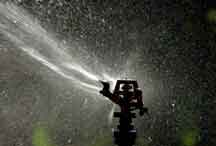Water restrictions almost seem to be the norm anymore making sprinkler system designs, irrigation and water use an ongoing hot topic. In the future we should only see more shortages and regulations placed on water use for both the homeowner and commercial operation.

Sprinkler system design, irrigation methods (like a drip irrigation system) and frequency will vary depending on the location, irrigation system ( sprinkler, drip, microjet), water quality and the type of plant or application needed.
No matter what the irrigation needs for home use or commercial it comes down to each person being responsible for putting into practice a water-use strategy. Knowledge is so important when considering any irrigation strategy. Here are a few topics to take into account when developing an irrigation plan.
Determine Water Needs
Watering, irrigating or running the sprinklers goes way beyond adjusting the timer of flipping on the pump. Before watering the current weather conditions, plant type(s), how well the plants and landscape are established and other factors. When the irrigation event happens and how much water is applied should not be based on the time of date but the needs of the plants being watered.
Prioritize Water Use
Different plants have different watering needs. Groups plants by watering zones and adjust watering by needs and not on time intervals like 45 minutes per zone.

Time Watering
The early morning and later in the evening are the most efficient times to water. The reason? Less surface evaporation allowing the soil soak up the water without fighting the sun and wind. The down side comes with potential disease issues on some plants, as the foliage may stay wet for long periods of time.
Water Evenly & Thoroughly
Watering needs to be done evenly through the entire zone. This problem does not only exist in the landscape but also container gardens and houseplants. Plants need complete and thorough watering and moisture.
Water Soil Not Foliage
Watering the foliage is very temporary. It only last until it drips off or evaporates. The water is of little benefit unless the plant can use it. Applying water directly to the soil or potting media is much more efficient and gives a lasting effect.
Minimize Leaching
This applies mainly to plants grown in containers. It’s important to evaluate how much water the plant needs to be thoroughly watered and reduce and additional run-off or leaching of fertilizers in the soil.
Spot Water
There are times when spot watering is needed. For example a new plant is planted in the ground or a container has been repotted on the patio or deck. When this is the case water by hand as needed and not turn the sprinklers on to water everything in the zone.
Use A Water Nozzle
When watering plants in containers or the landscape take advantage of water breakers and nozzles. They will help break the water flow and distribute the water easier and gently.
Add Shut Off Value To Hose
By adding a shut value to the hose you’ll be able to stop watering once the task is finished. This will conserve water and stop you from running back and forth to turn the hose off.
Maintain The System
Keep your irrigation and sprinkler system in good working order. Keep a watchful eye out for breaks, clogs and leaky valves. When you find these problems – fix them. The design of the sprinkler system, water and how we use it will continue to come under more scrutiny as the need for water grows. Learning to be efficient with our water use will allow us all to produce beautiful plants, landscapes and lawns.


Comments on this entry are closed.